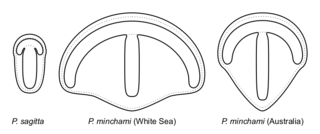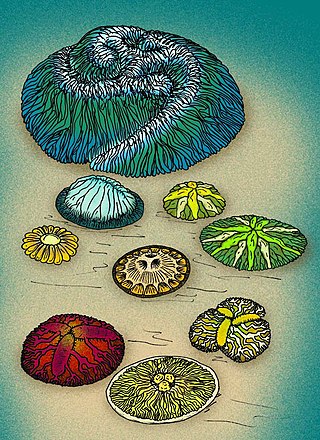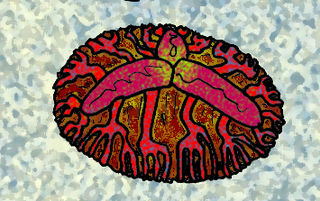
Bilateria is a large clade or infrakingdom of animals called bilaterians, characterized by bilateral symmetry during embryonic development. This means their body plans are laid around a longitudinal axis with a front and a rear end, as well as a left–right–symmetrical belly (ventral) and back (dorsal) surface. Nearly all bilaterians maintain a bilaterally symmetrical body as adults; the most notable exception is the echinoderms, which have pentaradial symmetry as adults, but are only bilaterally symmetrical as an embryo. Cephalization is a characteristic feature among most bilaterians, where the special sense organs and central nerve ganglia become concentrated at the front end.

Standard anatomical terms of location are used to describe unambiguously the anatomy of animals, including humans. The terms, typically derived from Latin or Greek roots, describe something in its standard anatomical position. This position provides a definition of what is at the front ("anterior"), behind ("posterior") and so on. As part of defining and describing terms, the body is described through the use of anatomical planes and anatomical axes.

Dickinsonia is a genus of extinct organism, most likely an animal, that lived during the late Ediacaran period in what is now Australia, China, Russia, and Ukraine. It is one of the best known members of the Ediacaran biota. The individual Dickinsonia typically resembles a bilaterally symmetrical ribbed oval. Its affinities are presently unknown; its mode of growth has been considered consistent with a stem-group bilaterian affinity, though various other affinities have been proposed. It lived during the late Ediacaran. The discovery of cholesterol molecules in fossils of Dickinsonia lends support to the idea that Dickinsonia was an animal, though these results have been questioned.

Kimberella is an extinct genus of bilaterian known only from rocks of the Ediacaran period. The slug-like organism fed by scratching the microbial surface on which it dwelt in a manner similar to the gastropods, although its affinity with this group is contentious.

Symmetry in biology refers to the symmetry observed in organisms, including plants, animals, fungi, and bacteria. External symmetry can be easily seen by just looking at an organism. For example, the face of a human being has a plane of symmetry down its centre, or a pine cone displays a clear symmetrical spiral pattern. Internal features can also show symmetry, for example the tubes in the human body which are cylindrical and have several planes of symmetry.

Tribrachidium heraldicum is a tri-radially symmetric fossil animal that lived in the late Ediacaran (Vendian) seas. In life, it was hemispherical in form. T. heraldicum is the best known member of the extinct group Trilobozoa.

The halkieriids are a group of fossil organisms from the Lower to Middle Cambrian. Their eponymous genus is Halkieria, which has been found on almost every continent in Lower to Mid Cambrian deposits, forming a large component of the small shelly fossil assemblages. The best known species is Halkieria evangelista, from the North Greenland Sirius Passet Lagerstätte, in which complete specimens were collected on an expedition in 1989. The fossils were described by Simon Conway Morris and John Peel in a short paper in 1990 in the journal Nature. Later a more thorough description was undertaken in 1995 in the journal Philosophical Transactions of the Royal Society of London and wider evolutionary implications were posed.

Yorgia waggoneri is a discoid Ediacaran organism. It has a low, segmented body consisting of a short wide "head", no appendages, and a long body region, reaching a maximum length of 25 cm (9.8 in). It is classified within the extinct animal phylum Proarticulata.

Parvancorina is a genus of shield-shaped bilaterally symmetrical fossil animal that lived in the late Ediacaran seafloor. It has some superficial similarities with the Cambrian trilobite-like arthropods.

Trilobozoa is a phylum of extinct, sessile animals that were originally classified into the Cnidaria. The basic body plan of trilobozoans is often a triradial or radial sphere-shaped form with lobes radiating from its centre. Fossils of trilobozoans are restricted to marine strata of the Late Ediacaran period.

The stylophorans are an extinct, possibly polyphyletic group allied to the Paleozoic Era echinoderms, comprising the prehistoric cornutes and mitrates. It is synonymous with the subphylum Calcichordata. Their unusual appearances have led to a variety of very different reconstructions of their anatomy, how they lived, and their relationships to other organisms.

The Ediacaranbiota is a taxonomic period classification that consists of all life forms that were present on Earth during the Ediacaran Period. These were enigmatic tubular and frond-shaped, mostly sessile, organisms. Trace fossils of these organisms have been found worldwide, and represent the earliest known complex multicellular organisms. The term "Ediacara biota" has received criticism from some scientists due to its alleged inconsistency, arbitrary exclusion of certain fossils, and inability to be precisely defined.

Anfesta stankovskii is a tri-radially symmetrical fossil animal that lived in the late Ediacaran (Vendian) seafloor. It is a member of the extinct group Trilobozoa.

The Chancelloriids are an extinct family of superficially sponge-like animals common in sediments from the Early Cambrian to the early Late Cambrian. Many of these fossils consists only of spines and other fragments, and it is not certain that they belong to the same type of organism. Other specimens appear to be more complete and to represent sessile, radially symmetrical hollow bag-like organisms with a soft skin armored with star-shaped calcareous sclerites from which radiate sharp spines.

Marine invertebrates are invertebrate animals that live in marine habitats, and make up most of the macroscopic life in the oceans. It is a polyphyletic blanket term that contains all marine animals except the marine vertebrates, including the non-vertebrate members of the phylum Chordata such as lancelets, sea squirts and salps. As the name suggests, marine invertebrates lack any mineralized axial endoskeleton, i.e. the vertebral column, and some have evolved a rigid shell, test or exoskeleton for protection and/or locomotion, while others rely on internal fluid pressure to support their bodies. Marine invertebrates have a large variety of body plans, and have been categorized into over 30 phyla.

Until the late 1950s, the Precambrian was not believed to have hosted multicellular organisms. However, with radiometric dating techniques, it has been found that fossils initially found in the Ediacara Hills in Southern Australia date back to the late Precambrian. These fossils are body impressions of organisms shaped like disks, fronds and some with ribbon patterns that were most likely tentacles.

The petalonamids (Petalonamae) are an extinct group of archaic animals typical of the Ediacaran biota, also called frondomorphs, dating from approximately 635 million years ago to 516 million years ago. They are benthic and motionless animals, that have the shape of leaves, fronds (frondomorphic), feathers or spindles and were initially considered algae, octocorals or sea pens. It is now believed that there are no living descendants of the group, which shares a probable relation to the Ediacaran animals known as Vendozoans.

Armillifera parva is a species of Ediacaran proarticulate first described by Mikhail Fedonkin in 1980. Its fossils were discovered in the White Sea area, Arkhangelsk Region, Russia. These fossils of A. parva were restricted to almost the same stratigraphic range as Kimberella, although fossils of both organisms have been rarely found.

Gehlingia dibrachida is a species of enigmatic Ediacaran organism from South Australia described in 1998. Gehlingia has been described as having many characteristics of petalonamids, although it has been classified as a rather close relative of the Tribrachidium. The overall shape of Gehlingia contradicts this affinity, however, with its shape being a more Bilaterally symmetrical one although the basic structure similar to that of Tribrachidium appears in Gehlingia as separate branches extending into bifurcating minor branches along with "thumb structures" that are apparent in Tribrachidium in the form of side bulges on an axis.

Escumasia roryi is a species of enigmatic animal from the Mazon Creek site. Due to the large quantity of fossils, it has acquired a common name, that being "wye" or "y-animal" in reference to its shape.




















